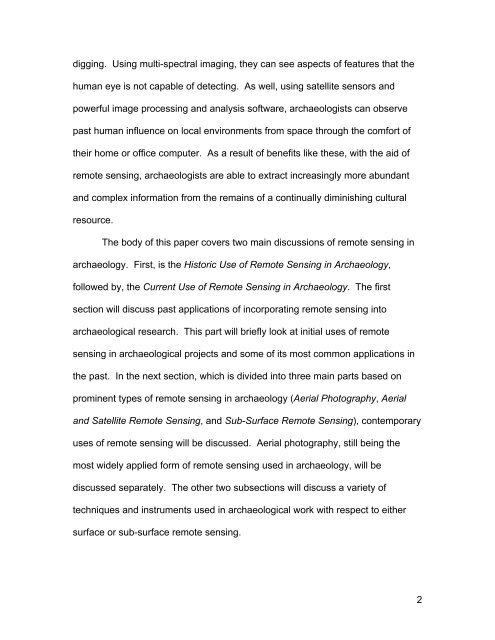A Review of Remote Sensing Application in Archaeological Research
A Review of Remote Sensing Application in Archaeological Research
A Review of Remote Sensing Application in Archaeological Research
You also want an ePaper? Increase the reach of your titles
YUMPU automatically turns print PDFs into web optimized ePapers that Google loves.
digg<strong>in</strong>g. Us<strong>in</strong>g multi-spectral imag<strong>in</strong>g, they can see aspects <strong>of</strong> features that the<br />
human eye is not capable <strong>of</strong> detect<strong>in</strong>g. As well, us<strong>in</strong>g satellite sensors and<br />
powerful image process<strong>in</strong>g and analysis s<strong>of</strong>tware, archaeologists can observe<br />
past human <strong>in</strong>fluence on local environments from space through the comfort <strong>of</strong><br />
their home or <strong>of</strong>fice computer. As a result <strong>of</strong> benefits like these, with the aid <strong>of</strong><br />
remote sens<strong>in</strong>g, archaeologists are able to extract <strong>in</strong>creas<strong>in</strong>gly more abundant<br />
and complex <strong>in</strong>formation from the rema<strong>in</strong>s <strong>of</strong> a cont<strong>in</strong>ually dim<strong>in</strong>ish<strong>in</strong>g cultural<br />
resource.<br />
The body <strong>of</strong> this paper covers two ma<strong>in</strong> discussions <strong>of</strong> remote sens<strong>in</strong>g <strong>in</strong><br />
archaeology. First, is the Historic Use <strong>of</strong> <strong>Remote</strong> <strong>Sens<strong>in</strong>g</strong> <strong>in</strong> Archaeology,<br />
followed by, the Current Use <strong>of</strong> <strong>Remote</strong> <strong>Sens<strong>in</strong>g</strong> <strong>in</strong> Archaeology. The first<br />
section will discuss past applications <strong>of</strong> <strong>in</strong>corporat<strong>in</strong>g remote sens<strong>in</strong>g <strong>in</strong>to<br />
archaeological research. This part will briefly look at <strong>in</strong>itial uses <strong>of</strong> remote<br />
sens<strong>in</strong>g <strong>in</strong> archaeological projects and some <strong>of</strong> its most common applications <strong>in</strong><br />
the past. In the next section, which is divided <strong>in</strong>to three ma<strong>in</strong> parts based on<br />
prom<strong>in</strong>ent types <strong>of</strong> remote sens<strong>in</strong>g <strong>in</strong> archaeology (Aerial Photography, Aerial<br />
and Satellite <strong>Remote</strong> <strong>Sens<strong>in</strong>g</strong>, and Sub-Surface <strong>Remote</strong> <strong>Sens<strong>in</strong>g</strong>), contemporary<br />
uses <strong>of</strong> remote sens<strong>in</strong>g will be discussed. Aerial photography, still be<strong>in</strong>g the<br />
most widely applied form <strong>of</strong> remote sens<strong>in</strong>g used <strong>in</strong> archaeology, will be<br />
discussed separately. The other two subsections will discuss a variety <strong>of</strong><br />
techniques and <strong>in</strong>struments used <strong>in</strong> archaeological work with respect to either<br />
surface or sub-surface remote sens<strong>in</strong>g.<br />
2
















